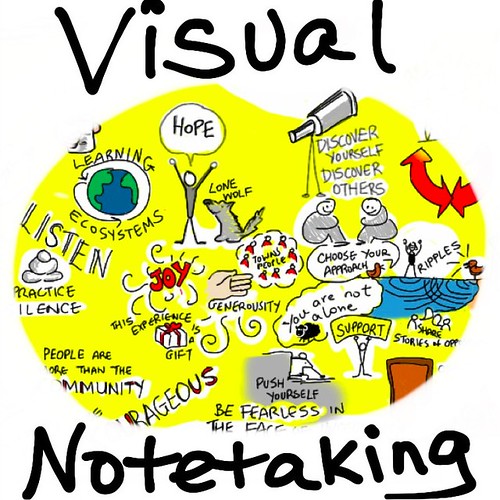Yesterday at the 2013 Tablet Summit in Montreal, Quebec, I shared a two-part breakout session on “visual notetaking.” These are visual notes created by two of the workshop participants, Tanya Avrith and Audrey McLaren.
Visual notetaking is a great learning strategy to demonstrate, practice, and promote with teachers for many reasons. First of all, we tend to exclusively value the transfer and demonstration of information in many classrooms with linguistic, linear, text-based, left-brained modalities at the expense of creativity and more artistic forms of expression. As Rachel Smith poignantly explained in her 2012 TEDx talk, “Drawing in Class,” this over-emphasis on traditional, text-based notes can significantly impair the learning of students who are more visually and artistically inclined. As Rachel says, visual notetaking “isn’t the only way to take notes” and isn’t always the best way to take notes in every situation. Visual notetaking IS a valid way to take notes which teachers should acknowledge, support, and even teach to to students.
During our visual notetaking session yesterday, I asked participants to summarize their learning from part 1 and share it with others at their tables. Some people stayed for part two, and some new folks came just for part two. Two table groups had participants who agreed to create some brief “visual art” examples using their drawings and narrated them to highlight things they’d learned and discussed about visual notetaking. We used the classic AudioBoo iOS app (free) on my iPad to capture and record these short reflections, and I put them into an AudioBoo “board” so they play as a playlist.
This was the first opportunity I’ve had to teach visual notetaking in a two-part series, so I shared “whiteboard animation” as a more sophisticated way to take visual notetaking to “the next level.” I have several different apps and examples of whiteboard animation listed on the “Visual Notetaking” page of Mapping Media to the Common Core. Rachel Smith’s video “Visual Recording on the iPad” is one example we saw yesterday, along with the start of “Drive: The surprising truth about what motivates us” by RSA Animate. I shared my first whiteboard animation video, “Why Become a Storychaser?” which I created last week in a couple hours using the $5 iPad app VideoScribe HD.
Two other resources I learned about as a result of our workshop, thanks to Susan van Gelder, are the books “The Sketchnote Handbook Video Edition: the illustrated guide to visual note taking” and “Steal Like an Artist: 10 Things Nobody Told You About Being Creative” by Austin Kleon. I also added “The Graphic Facilitator’s Guide: how to use your listening, thinking and drawing skills to make meaning”” by Brandy Agerbeck to my Amazon wish list.
If you’re not already sharing visual notetaking with your students as a learning strategy for more deeply processing information and ideas, you need to! Visual notetaking rocks!




Comments
2 responses to “Learning More About Visual Notetaking (Authorized Drawing in Class!)”